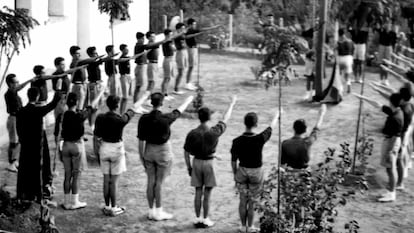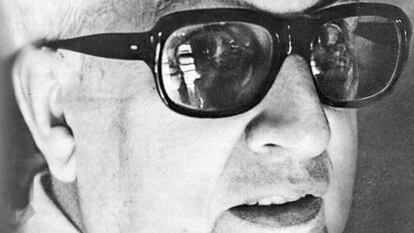What has to happen for the son of a military man, born in a right-wing environment, gentrified in the Salamanca neighborhood, to join the Communist Party? What did Franco’s private confessor and his wife, chaplain of the Falangist Youth Front, have to have seen in 1943 to make the raised fist gesture at the historic rally? red 1977 in the Vallecas stadium? How does a man join the side that killed his two brothers, one of them tortured? The documentary tries to respond to all this. A man without fear, by Juan Luis de No, released in theaters this Friday. This is the portrait of the Jesuit José María de Llanos, one of the spiritual fathers of the Spanish left, who went from one end of the ideological spectrum to the other after entering the suburbs of Madrid, mainly in the Pozo del Tío Raimundo, a neighborhood where helped and encouraged its inhabitants to fight for basic services.
“See and know that in our city, overwhelmed and distressed by the tremendous shortage of rooms, there are large and even enormous apartments, completely closed by their owners who barely occupy them occasionally during the year. It is something that certainly revolts the earth. It is confirming the existence of a capital that does not fulfill its most basic function of serving the common good. “It becomes a real insult and a mockery,” Llanos wrote in the movement’s newspaper. Above in 1956. A few months ago he had left his residence in the center of the capital and had moved to Pozo. There he was able to verify the conditions in which some 2,040 families lived.
The photographs that the film rescues show smiling people on a floor full of mud, on which shacks, some even made of cardboard, are built. “Those from outside knew that we were from Pozo because of the mud we had on us,” recalls in the documentary a neighbor of that illegal settlement, one of many that were built on the outskirts of Madrid, populated by migrants, mainly from Extremadura and Andalusia. , moved by the poverty of the first Franco regime in the forties and fifties.
Llanos’ help ranged from preventing the Civil Guard from demolishing the houses as part of the plan to eradicate the shanty town —”he told them that the Vatican had taken possession of the huts”— until he collaborated in the construction of the first water tank and set up the El Pozo Electric Cooperative that brought light. “Llanos had that drive to want to change the world that appears when you are young and you don’t know how to channel it. Entering the Franco regime was a very great disappointment for him because the new Spain for all that Franco promised did not happen, more than half of Spain was being excluded, abandoning them in poverty, and that upset him inside,” comments the director. of the film, Juan Luis de No. Born in Carabanchel, the director says that his initial intention was to make a film about the cooperation between the neighborhoods of Vallecas for their development, but in the investigation the figure of the Jesuit was inevitable. “He was present in everything, like a catalyst. When I got to know his story in depth, I realized that he was the character with the most strength, with a brutal dramatic arc, to tell what he wanted.”
The author of the biographical book of Llanos Blue and red (2013), Pedro Miguel Lamet, says in one of his interventions in the film that he knows the exact moment in which the priest’s transformation occurs. “One day he was on an excursion with a group of Falangists from the Youth Front and while making a camp fire he climbed up a grove and from there he saw that town, it was poor, hungry Spain; He said, ‘What am I doing here?’ He went to convert the neighbors and the neighbors ended up converting him.
One of his first tasks upon arriving at the Well was to build a church and May Day school, with a Christian educational basis. But he provided training that confronted the ecclesiastical hierarchy: “he allowed himself to be influenced by liberation theology in his correspondence with fathers from Latin America,” according to Luis de No.
Llanos is only one of the parts, although perhaps the most visible, that make up the mosaic of the clerics who fought for the rights of the neighborhood and proletarian movements during the Franco regime and the Transition. The May 28, 1977 edition of EL PAÍS featured on the cover a photograph of Llanos with his fist raised at the rally of the newly legalized Communist Party with the caption: “In some way, it comes to symbolize the historic commitment of certain church that painfully passed from national-Catholicism to the greeting of Marxist identification.” Llanos attended the event with another religious person, José María Díez-Alegría, one of his most important allies in El Pozo, along with the lawyer Paca Sauquillo, also raised by a military and wealthy class father, who went to offer legal protection every night. to the reprisals who arrived at the settlement.
Francisco García Salve or Diamantino García are other names of priests who identified themselves with the disadvantaged classes of the time. The first was arrested by the regime because of his union activity with the National Confederation of Labor and Workers’ Commissions, while García mobilized landless day laborers from Los Corrales (Seville) and was one of the founders of the Workers’ Union of the Campo (SOC), in 1976. Part of the fight of the rebels in cassocks is reflected in another documentary, From the cross to the hammer (2018). To stop them, Franco ordered the construction in 1968 of a specific prison for priests who he considered to be opponents, the Cárcel Concordataria de Zamora.
How Llanos managed to be immune to censorship and retaliation is a topic of discussion among the film’s interviewees (neighbors, comrades in the neighborhood struggle and personal friends). He attended the clandestine meetings and assemblies organized by the communists in schools. Some believe that this shield had to do with the affection that the Generalissimo would develop towards him the year in which Llanos led him, together with his wife, in the spiritual exercises. The activist who lived in El Pozo for 15 years to work alongside the priest and his gateway to Comisiones Obreras, José Luis Martín tells how Llanos once stood up the dictator. “Franco came to Pozo from El Pardo to inaugurate a school called Jesús Rubio, in front of the chapel complex where Llanos, who had gone on an excursion that day with his students to the mountains, had his residence. He didn’t want to receive it, it was a gesture of ‘we don’t want anything with you in this neighborhood’. The superiors of the Society of Jesus forced him to apologize.”
The guests in the documentary describe Llanos as “impatient”, “with a strong character” or “slightly elitist, like all Jesuits”, according to Miguel Ángel Pascual, former president of the Pozo Neighborhood Association, where he lived for 50 years. . The interviews with the friends are completed in the film with their appearances on TVE in the eighties, a brief media period. Luis de No also relies on enormous photographic material – he had access to more than 2,500 snapshots – and videos that come mostly from the archive of Tino Calabuig, one of the members of the Madrid Film Collectiveyoung filmmakers who took to the streets with 16-millimeter cameras to record the repression in the second half of the seventies.

The filmmaker conveys the tension and atmosphere of anxiety in a long violent era in the history of Spain. The blood traces a chronological line in the film, from the Paracuellos massacre (1936), three months after the start of the Civil War where civilians, soldiers and religious people were shot just for being right-wing, until Atocha (1977), where five labor lawyers died at the hands of a far-right group, two years after the death of Frank. A man without fear It is also a chronicle of a turbulent time of change that ended with the priest’s death in 1992.
He died in a Jesuit residence in Alcalá de Henares, where he spent only a few months, before pneumonia forced him to leave El Pozo and have personalized assistance. He was laid to rest in the neighborhood parish that he helped build. Hundreds of people attended, followers, important personalities from the left such as Javier Solana and Julio Anguita, but also their religious colleagues from a more conservative wing. “At the same time they sang The International and the mysteries of the rosary,” says Lamet. It was the peak of that symbiosis between Marxism and the most primitive Christian thought.

Two years after his death he rose a monument in his name in a park in the center of El Pozo, where the symbolic streets of Cooperativa Eléctrica and Vecinos de El Pozo adjoin. But the greatest tribute is that the first school that he built, May Day, still stands, along with other institutions that the José María de Llanos Foundation, such as the Southern Hospitality School and the Madrid Women’s Space. Fragments of a legacy that remembers him not as the person responsible for the reform of the Pozo, Martín emphasizes, but as an encourager “of the neighbors so that they would take the reins of things.” Like the man who was not afraid.
All the culture that goes with you awaits you here.
Babelia
The literary news analyzed by the best critics in our weekly newsletter
RECEIVE IT
_




